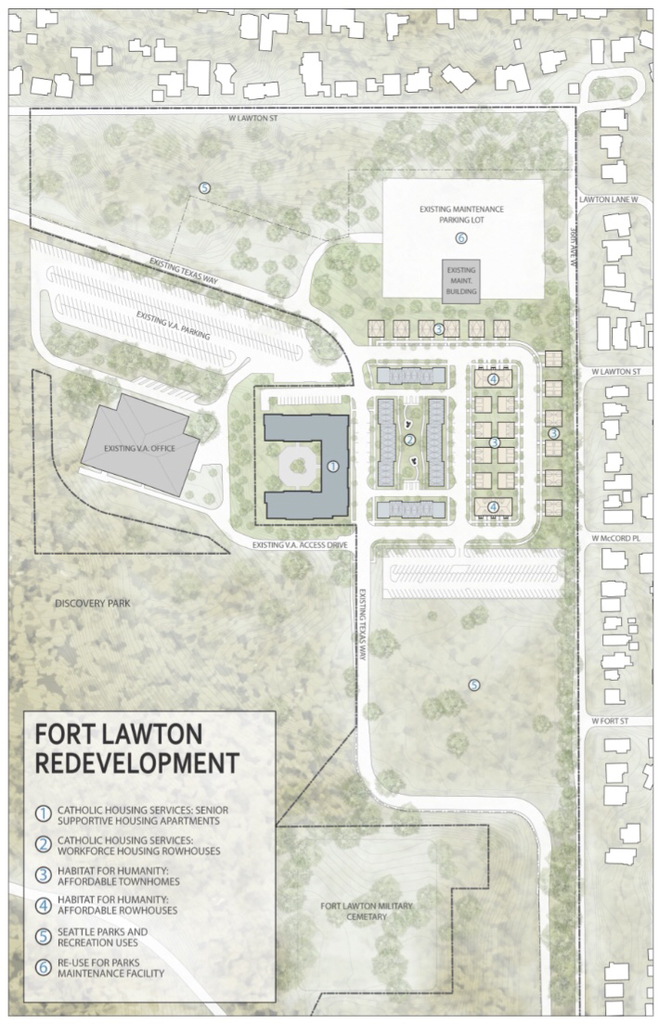
Tomorrow night, the city is holding a pivotal meeting on the future of property adjacent to Discovery Park in Magnolia: will the possibility of much-needed affordable housing at the former home of Fort Lawton finally be realized? Or will concerns around impacts to the neighborhood cause the site to become merely more park space in a neighborhood that doesn’t really have a park space deficit?
As Doug Trumm reported last June, the future of the last developable site at the federal site of Fort Lawton, an army base dating to 1890, has been in question since 2005. A decade ago the city tried to pursue housing on the site and was stymied by a lawsuit brought by neighborhood residents–the Great Recession put the plans on ice until now. The city is currently proposing that all of the housing built on the site be affordable housing for various income levels. A total of 238 units are proposed, including 85 units for formerly homeless seniors, 100 affordable apartments, and 52 affordable homeownership opportunities in the form of rowhouses and townhouses.
The Draft Environmental Impact Statement (DEIS), the latest hurdle that the development is set to clear before becoming a reality, was released by the Office of Housing last month. The alternatives studied in it included only building market-rate housing on the Fort Lawton site and building affordable housing at an alternate site in Laurelhurst, and also turning the entire Fort Lawton site into only additional park space. But the park space-only proposal would only include 10 acres more than is proposed in the full affordable housing proposal.
Heidi Groover at The Stranger broke down the various Magnolia residents who oppose the project in a must-read piece on Slog last month. She quotes Elizabeth Campbell, who led the first lawsuit against the city over housing on the Fort Lawton site:
“I don’t consider it opposition to the housing because that’s a storyline that the housing people like to run, that the homeless people might like to run, that the city might like to run.” Asked about the homelessness crisis and lack of affordable housing, Campbell cuts the question short. “I’m not going to go into the homelessness thing…The homelessness people can go into their own spiel. It’s the park that I’m working on.”
She notes that our current homelessness emergency requires a massive investment in housing for both those experiencing homelessness now or those at risk of becoming homeless due to economic displacement. While the addition of an additional 12 acres (on top of what’s proposed in this development plan) to Discovery Park’s current expanse of 534 clearly doesn’t pose a compelling alternative to the ability to take a small step toward alleviating our homelessness crisis, ultimately it may be up to the hearing examiner to determine if the city dotted its i’s and crossed its t’s. However, public support for the project from all over the city will go a long way toward furthering the goals of the Office of Housing with this proposal.

With the appeal of every EIS from citywide Mandatory Affordable Housing (MHA) to the city’s backyard cottage proposal, appeal of this EIS seems all but a certainty. Whether the time has finally come for Fort Lawton could be determined this year; the Office of Housing plans to submit a full redevelopment plan to the city council this summer for approval.
Comments on the DEIS can be emailed to OH_comments@seattle.gov and must be submitted on or before January 29th. The public open house tomorrow night (Tuesday, January 9th) will be at 6pm at 3555 W McGraw St, Seattle. If you pick this event over our monthly meet up at the same time, we completely cheer you on.
Seattle Office Of Housing Plans 235 Affordable Homes At Fort Lawton
Ryan Packer has been writing for The Urbanist since 2015, and currently reports full-time as Contributing Editor. Their beats are transportation, land use, public space, traffic safety, and obscure community meetings. Packer has also reported for other regional outlets including BikePortland, Seattle Met, and PubliCola. They live in the Capitol Hill neighborhood of Seattle.

